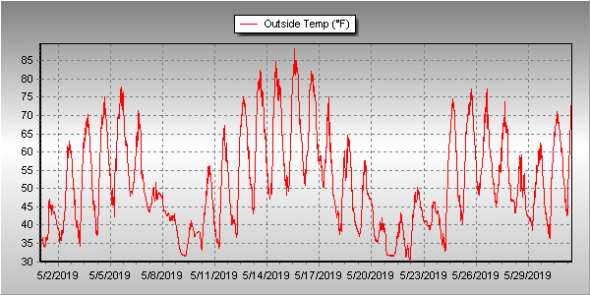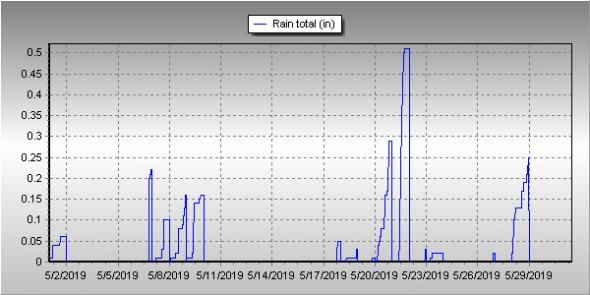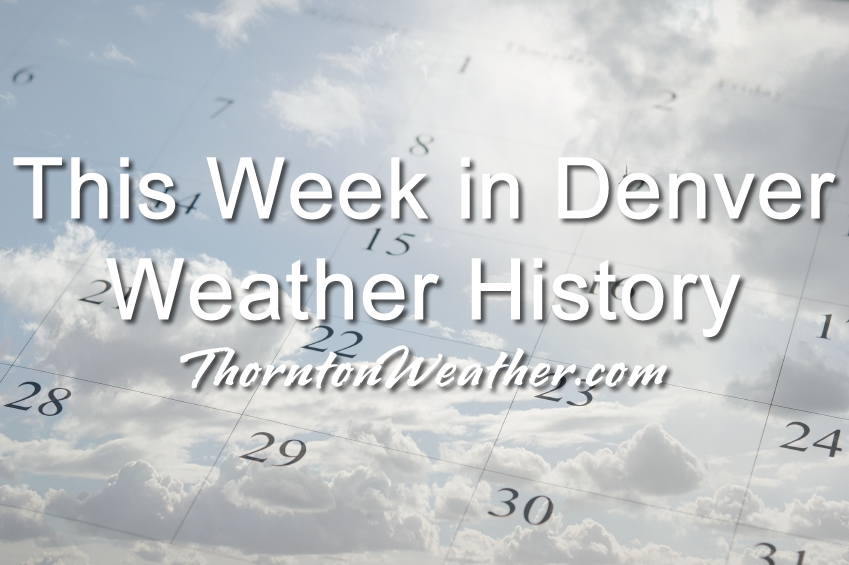An extremely eventful week in Denver weather history. Most notably for longtime Thornton and Northglenn residents is the 28 year anniversary of the infamous Thornton Tornado which struck on June 3, 1981.
From the National Weather Service:
26-31
In 1995…a cool period with light morning showers and moderate to heavy afternoon showers and thunderstorms pushed rivers already swollen from mountain snow melt over their banks causing minor flooding. Streams and rivers such as the South Platte and Boulder Creek flooded meadowlands…bike paths…roads near streams…and other low lying areas. No significant property damage was reported and crop damage was unknown. Rainfall totaled 1.79 inches at the site of the former Stapleton International Airport and only 1.51 inches at Denver International Airport.
29-1
In 1894…heavy rain combined with snowmelt runoff caused widespread flooding over the South Platte River basin. Rainfall was heaviest in the foothills where 5 to 8 inches were measured over the 4 days. Heavy rainfall west of Boulder flooded mining towns and damaged mining properties. In the canyons above Boulder…railroads and roads were washed out along with many bridges. The floodwaters spread into central Boulder and covered a wide area from University Hill north to near Mapleton Hill to a maximum depth of 8 feet. Many houses were swept away…and every bridge in Boulder was destroyed. A few people…trapped in their homes by the floodwaters… Had to be rescued. However…the gradual rise of the flood waters resulted in only one death. Boulder Creek spread to a width of nearly one mile in the pasture land to the east of Boulder. Extensive flooding on Left Hand Creek north of Boulder washed away railroad and wagon bridges. The heavy cloudbursts caused flooding on Bear Creek…which washed away bridges…railroad tracks…and structures and destroyed the canyon roadway. Morrison sustained the heaviest flood damage on bear creek. In Denver…rainfall totaled only 1.50 inches on the 30th and 31st…but the heavy rainfall on upstream tributaries of the South Platte River caused the river to rise as much as 10 feet above the low water mark in the city…which caused some flooding of pasture land downstream to a depth of 6 feet near Brighton.
30-31
In 1935…heavy thunderstorm rains overnight caused flash flooding east of the city on both Kiowa and Bijou Creeks… Resulting in a total of 9 deaths. Most of the damage was on Kiowa Creek where there were more structures. The water rose rapidly during the storm…ripping houses and stores from their foundations and sweeping them downstream. Precipitation in Denver totaled only 0.01 inch. Hail fell in the city for a short time. The hail was very small and caused no damage.
In 1983…a late storm of rain and snow hit the Front Range. Over an inch of rain fell at some spots…and above 7 thousand feet…1 to 5 inches of snow whitened the ground. Some snow flakes even fell in the western suburbs of metro Denver on the night of the 30th.
In 2002…unseasonably warm weather at the end of the month resulted in 3 temperature records. High temperature of 91 degrees on the 30th equaled the record maximum for the date. Low temperature of 61 degrees on the 31st was a record high minimum for the date. High temperature of 93 degrees on the 31st was a record maximum for the date.
31
In 1917…rainfall totaled 0.55 inch and was mixed briefly with snow around midday. Only a trace of snow fell. Cold temperatures during the day resulted in a high of 44 degrees and a low of 35 degrees. The month closed as the coldest May on record with a mean temperature of only 48.7 degrees…about 8 degrees below normal. The cold temperatures during the month had a marked effect on shade trees and shrubs in the city. Elms were just starting to leaf. Leaves on cottonwoods and maples were only half formed. Lilacs were just blooming…and snowball clusters would not bloom for days.
In 1959…the public reported a tornado briefly touching the ground 10 miles south of Stapleton Airport. No damage was reported.
In 1984…a thunderstorm microburst produced a wind gust to 67 mph…7 miles east of Boulder.
In 1991…hail to golf ball size pummeled southern and southeastern sections of metro Denver and continued on east to Watkins. Several houses and cars were damaged. Later… Thunderstorms dumped heavy rain across the city of Denver… Causing street flooding in an area just south of downtown and just northwest of downtown. Water was up to 10 inches deep over northwest Denver. A brief tornado touched down in Castle Rock where 3/4 inch diameter hail also fell.
In 1993…thunderstorms dropped dime size hail in Commerce City.
In 1994…lightning struck an apartment in Louisville and damaged electronic equipment…including a computer.
In 2006…a severe thunderstorm produced 1 inch diameter hail near Boulder.
1
In 1875…a windstorm during the late afternoon and early evening produced sustained winds to 50 mph.
In 1898…south winds were sustained to 41 mph with gusts to 46 mph.
In 1917…a trace of unmelted snow fell in downtown Denver. Precipitation for the day totaled 0.08 inch…half of which was estimated to be from melted snow.
In 1919…snowfall of 0.4 inch was measured in downtown Denver. This was the greatest calendar day and 24-hour snowfall ever recorded during the month of June. Precipitation (rain and melted snow) totaled 0.15 inch. Two temperature records were set. The low temperature of 32 degrees was a record minimum for the date. The high temperature of only 40 degrees was a record low maximum for the date and the month. North winds were sustained to 36 mph with gusts to 40 mph.
In 1951…a trace of snow fell at Stapleton Airport.
In 1961…hail as large as 1 1/2 inches in diameter fell in west Denver with hail to 1 1/4 inches reported in derby.
In 1965…a man struck by lightning in southeast Denver died shortly after being admitted to a hospital. Lightning damaged power lines in east and southeast Denver.
In 1980…strong thunderstorm winds blew in the windows of a mobile home in Northglenn.
In 1990…a thunderstorm produced wind gusts to 63 mph in Boulder. A small tornado touched down in a farmer’s field between the towns of Louisville and Lafayette. Another tornado was spotted in an open field 3 miles west of Brighton. A funnel cloud was sighted near Hudson. A microburst wind gust to 55 mph was recorded at Stapleton International Airport. No damage was reported from any of these events.
In 1991…severe thunderstorms producing large hail…damaging winds…funnel clouds…and heavy rain were widespread across metro Denver. Funnel clouds were reported in Lakewood… Boulder…Arvada…and just east of the rocky mountain arsenal. Hail up to golf ball size fell in Lakewood…just west of Sedalia…in Littleton…Arvada…Englewood…and the city of Denver. A mobile home park in Jefferson County reported hail to 3 feet deep. Up to 1.00 inch of rain fell in 45 minutes near Boulder…causing Boulder Creek to flow out of its banks. Rock and mud slides forced the closure of many roads in Boulder County. Later in the afternoon thunderstorms produced rainfall amounts of 2 to 3 inches over a couple of hours. Clear Creek in Golden spilled over onto U.S. Highway 6. Heavy rains washed away part of a bridge near Erie. Water was up to 18 inches deep in Westminster. Wind gusts to 58 mph were reported at Stapleton International Airport where 1/4 inch hail fell… And heavy thunderstorm rainfall totaled 0.82 inches…briefly reducing the visibility to 1 1/4 miles. Estimates of total damage from these storms would exceed 7 million dollars.
In 1994…hail up to 1 inch in diameter fell over south Denver and Littleton.
In 1997…two short lived-tornadoes formed near Bennett…but did no reported damage.
In 2002…strong winds from the outflow of dissipating showers developed to the east of Denver. Near Strasburg…a spotter recorded a wind gust to 58 mph.
1-2
In 2002…unusually very warm weather for so early in June resulted in two temperature records. Maximum temperatures of 96 degrees on the 1st and 93 degrees on the 2nd were record highs for each date…respectively.
1-4
In 1977…unusually warm weather for this early in June resulted in 3 maximum temperature records being equaled at the time: 88 degrees on the 1st…90 degrees on the 2nd… And 93 degrees on the 4th. Maximum of 91 degrees on the 3rd was not a record.
1-30
In 2012…it was the hottest June in Denver since weather records began back in 1872. The average temperature for the month was 75.0 degrees which was 7.6 degrees above normal. There were a total of seventeen 90 degree days in the month of June. The highlight of record setting month was a stretch of five consecutive 100 degree days from the 22nd to the 26th. This was only the third time in Denver weather history in which this happened. Two of the high temperatures during the stretch peaked at 105 degrees… Which set the all-time record for the month of June and tied the all-time maximum temperature for Denver.
2
In 1914…flooding occurred on Boulder creek when heavy rains added to heavy snowmelt runoff. Flooding damaged the water supply system from the mountains into Boulder and destroyed roads and bridges in the canyons above Boulder. The flooding in central Boulder was described as the worst since the tragic flood of May 29th through June 3rd in 1894. However…there was no reported loss of life. The flood waters also inundated pasture land to the east of the town.
In 1951…the lowest recorded temperature in June…30 degrees… Occurred. The unusually cold weather was accompanied by 0.3 inch of snowfall. Precipitation…both rain and melted snow…totaled 0.30 inch.
In 1966…microburst winds gusted to 51 mph at Stapleton International Airport.
In 1981…a severe thunderstorm roared through metro Denver… Dumping 2.00 inches of rain in as little as 20 minutes and bombing many areas with hail to 1 3/4 inches in diameter. The heavy rain caused local flooding with up to 3 feet of water in some streets in northwest metro Denver. Part of a street was washed out in Thornton. Lightning strikes started a fire and caused a power outage just north of Denver. Lightning also struck a barn which burned to the ground in Brighton. Numerous cars sustained minor hail damage. A tornado was spotted 4 miles northeast of the rocky mountain arsenal…but caused no damage.
In 1982…severe thunderstorms produced large hail across metro Denver. Hail to 3/4 inch in diameter was reported in Louisville and northeast Denver. Golf ball size hail fell near Strasburg where two tornadoes were also sighted.
In 1983…a tornado touched down 5 miles south of Bennett. It destroyed an outbuilding and did extensive damage to greyhound dog shelters. Golf ball size hail fell near the tornado…destroying some hay.
In 1985…3/4 inch hail fell in southwest metro Denver.
In 1989…large hail fell over eastern and central Denver. A few stones were as large as baseballs…and many ranged from 3/4 inch to golf ball size. The hail piled up 2 to 4 inches deep in some areas. Hail to 3/4 inch fell at Buckley Field in Aurora…and 7/8 inch hail fell just east of Aurora. A home in Louisville was struck by lightning and was 30 percent destroyed by the ensuing fire.
In 1991…strong thunderstorm winds in Arapahoe County…14 miles southeast of Stapleton International Airport…damaged the roof of a home and a radio antenna. A funnel cloud… 4 miles northeast of Stapleton International Airport…was sighted for 11 minutes by national weather service observers.
In 1993…a tornado touched down briefly in south Denver… Destroying the 4-inch thick concrete roof of a building and causing about 20 thousand dollars in damage. The twister also picked up a trash dumpster and dropped it onto a car 30 feet away…causing an estimated 3 thousand dollars in damage. Hail up to an inch in diameter fell in Aurora… Conifer…and Bennett. Two funnel clouds were spotted near Deckers. A funnel cloud was sighted for 19 minutes by national weather service observers to the southwest of Stapleton International Airport.
In 1994…lightning struck two homes in Denver…starting fires which caused considerable damage to both. Hail to 3/4 inch in diameter fell in Golden.
In 1995…lightning struck a house in Nederland…causing a fire that was doused by subsequent rainfall. A portion of the roof and wall was damaged. The storm also left most of Nederland without power for two hours. Lightning also struck a high chimney of an elementary school in west Denver. The jolt sprayed bricks around the school yard and parking lot. Twenty students and teachers were in the school building at the time…but all escaped without injury. A funnel cloud was sighted over Fort Lupton…and 3/4 inch hail fell in Lafayette.
In 2003…severe thunderstorms produced strong winds and large hail. Hail as large as 1 1/2 inches in diameter fell near Parker. Estimated wind gusts to 70 mph occurred near Parker and near Denver International Airport where thunderstorm wind gusts to 52 mph were recorded. Wind gusts to 60 mph were estimated near Bennett.
In 2005…a severe thunderstorm produced hail as large as 1 inch in diameter in the city of Denver. A tornado was sighted near Bennett along with 3/4 inch hail.
In 2008…severe thunderstorms produced large hail over western Arapahoe…northern Denver and southern Weld counties. Hail…2 inches in diameter…was observed near Brighton; with hail to 1 1/2 inches in diameter…5 miles east of prospect. Hail to one inch in diameter was observed near Buckley Field…Frederick and Denver.
In 2012…severe thunderstorm produced damaging thunderstorm winds. Peak wind gusts included: 82 mph near Strasburg… 61 mph at Buckley Field…60 mph near byers and southwest Denver…58 mph near Watkins and 52 mph at Denver International Airport. The microburst winds caused extensive tree and roof damage. In addition…hail up to 1 inch in diameter was reported 3 miles east-southeast of Parker.
2-4
In 1989…heavy rain drenched metro Denver with the greatest amounts recorded on the 3rd. Total rainfall ranged from 1 1/2 to 3 inches. Roads were washed out in Boulder County… And flooded basements caused water damage to houses in the Gunbarrel section of Boulder. In suburban Denver…heavy rain caused minor flooding along Lena Gulch in Jefferson County where two mobile home parks were evacuated. Rainfall totaled 1.66 inches at Stapleton International Airport.
Continue reading May 31 to June 6: This week in Denver weather history






